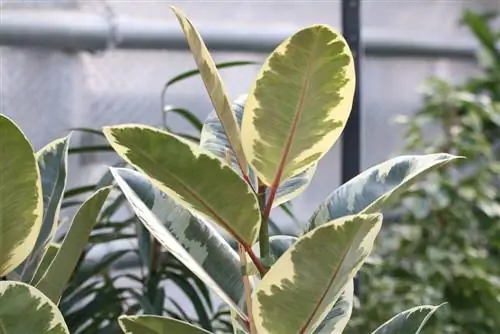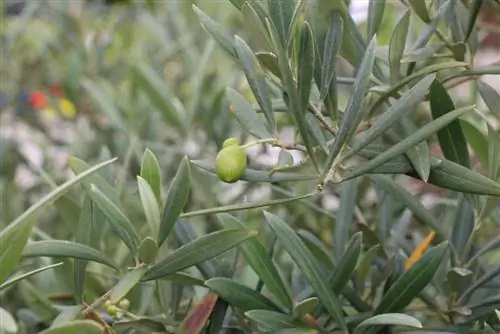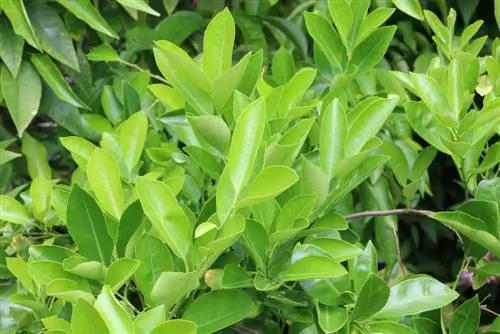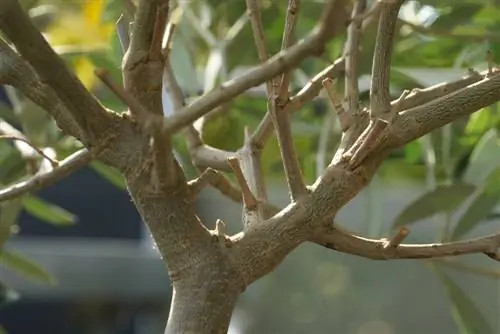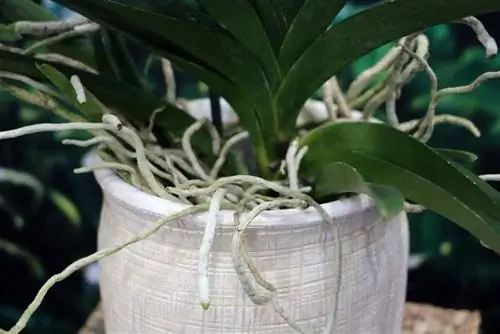- Author admin [email protected].
- Public 2023-12-17 03:39.
- Last modified 2025-01-24 12:45.
Ficus elastica is not a relic from the past, but is still very popular as a houseplant. With its impressive size, the Asian plant adorns reception areas, waiting rooms, offices and living rooms. The tree is considered robust, care is easy and takes little time. Nevertheless, various causes can cause the resilient plants to lose their leaves. The reason for this is not always immediately apparent at first glance.
Popular ornamental plant
The rubber tree is one of the classic houseplants. Since the 1960s, the mulberry plant has been decorating domestic living and office spaces with its impressive size. Under optimal conditions, the plant can reach an impressive height of over 3 meters with its strong green and shiny leaves. In general, the ficus, which comes from Asia, is considered robust and requires little care. The plant can cope with short-term drought without any problems.
It is also not uncommon for Ficus elastica to lose many of its older leaves in winter. The tree thus reacts to the changed lighting conditions. If all conditions are met, the plant becomes a perennial, lushly growing companion. However, the resistant plants do not tolerate everything. Various causes can lead to discoloration and loss of leaves.
Watering correctly
The rubber tree loves a bright place in living rooms, offices or winter gardens. At temperatures above 18° C, the plant from the mulberry family develops its attractive foliage. The tree should not be exposed to a colder environment. How light or dark the location can be depends on the respective variety. Ficus elastica tricolor, for example, requires more sunlight for its striking leaf color than the dark green colored Ficus elastica robusta.
With plants purchased from the supermarket, the changed lighting conditions can cause individual leaves to fall off. The plants need some time before they get used to their new habitat. However, if older rubber trees lose their leaves without moving, caution is advised. A possible cause could be the incorrect supply of water.
- Thrives in sunny to partially shaded locations
- Cannot tolerate full midday sun
- Ficus are sensitive to waterlogging
- Calciferous water does not harm the plants
- The top layer of substrate must be dry before watering
- Water moderately between October and February
If your rubber tree drops a lot of leaves, you should first check the moisture content of the soil. Asian trees can cope with short-term drought. If the plant is not watered for a long period of time, the foliage loses its firm structure and takes on a pale color. Standing water in the planter or saucer can also cause leaves to fall off. Waterlogging can have a dangerous effect on the mulberry plant. Fungal pathogens take advantage of the moist environment and attack the roots of weakened plants.
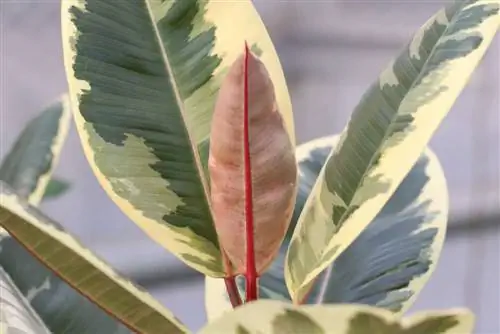
The root rot caused cannot be cured with fungicides or other home remedies. In addition to proper watering, drainage at the bottom of the container can protect the underground parts of the rubber tree. The dipping method has proven successful for watering Asian ornamental trees. With this measure, the entire planter is immersed in lukewarm water until no more air bubbles emerge from the substrate.
If the soil is completely dry, this method may have to be repeated several times. The water must completely penetrate the entire globe. During the main growing season, this process should be carried out approximately every 14 days. Between October and February, the plant reduces its metabolism to a minimum and the water requirement is also reduced.
Tip:
Give the plant a complete shower every now and then. With this method, the film of dust and dirt is washed away from the leaves.
Nutrients
In addition to something that is too dark orAiry location or incorrect watering can also be responsible for the loss of leaves. The rubber tree is one of the weakly consuming plants. Too high a dose of fertilizer affects the roots of the plant and can cause damage. The foliage turns a pale yellow color and dies.
- Stop nutrient intake in winter
- A liquid or long-term fertilizer has proven effective between March and August
- Fertilize approximately 21 days apart
- Reduce the amount of fertilizer indicated on the packaging
Organic fertilizers such as compost, coffee grounds or rock dust are unsuitable for houseplants. The small vessels lack the microorganisms that convert the material into valuable nutrients in a short time. In many cases, rot occurs, which can damage the trees. However, the ficus has no objection to the occasional administration of diluted nettle decoction. Over-fertilization can also cause similar symptoms on the plants. In this case, move the ficus into fresh substrate and stop fertilizing completely for one to two months. The ornamental trees need a little longer to regenerate from such damage.
Lack of space
The exotic plants with leathery leaves grow slowly. Rubber trees only need to be moved to a new, larger container approximately every 2 to 3 years. If you delay this measure unnecessarily, it can have a negative impact on the development of the plants. The result is stunted growth and the loss of leaves. If the roots of the trees completely fill the pot, it needs to be repotted. Unless it's an emergency, you should do this work in the spring.
- Remove the old substrate generously
- Create drainage in the new bucket
- The new vessel should be only slightly larger than the one previously used
The plants are suitable for cultivation in hydroponics. However, do not make the mistake of switching from soil to inorganic materials. The substrate must be completely removed from the roots so that mold does not form in the damp environment. When repotting older trees, you should always use the material you previously used.
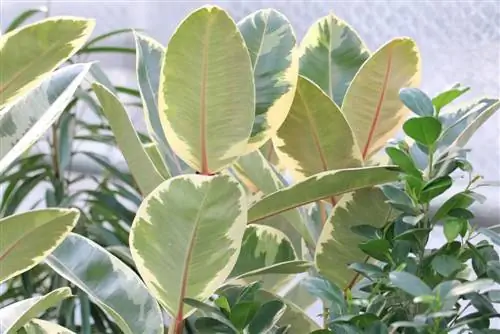
Tip:
Rubber trees can become “top heavy” as they age. If necessary, weigh down the soil decoratively with stones so that the plant does not become a victim of gravity.
Measures in the event of a complete loss of leaves
It is unusual for a mulberry plant to lose all its leaves. If the root network is intact and does not show any major damage, the Ficus elastica is not yet suitable for household waste.
- Control the underground parts of plants
- Transfer the plant to a partially shaded, warm location
- Do not allow the substrate to dry out
- Do not fertilize
Due to the slow growth, it can take 2 to 3 months before new buds appear. Don't lose patience. Cutting back the plant is not always successful. Done incorrectly, this measure can also lead to the death of the rubber tree. The tree no longer sprouts in the area of the woody stems. Leave a few centimeters of unwoody shoots.
You can try a trick to encourage the plant to sprout new leaves quickly:
- Slightly scratch woody shoots with a sharp knife
- Wrap the interface with a wet tissue or cotton wool
- Keep the material moist
- Check after 3 to 4 weeks
- Room temperature should be between 18° and 22°C
It makes sense to find the reason for the complete loss of foliage. If the location is a possible cause, you should avoid this place in the future.
Varieties
The different varieties of “Ficus elastica” have different requirements for their location. To avoid losing leaves, the right place should be found for each rubber tree.
Ficus elastica tricolor
This ornamental tree is one of the ornamental foliage plants. The strikingly colored leaves with the yellow-red edge need a lot of light to develop their full splendor. A few hours of sunshine a day are enough.
Ficus elastica variegeta
The yellow-edged and spotted leaves characterize this rubber tree variety. The location should be bright, but avoid direct sunlight.
Ficus elastica doerschi
Closely related to the Ficus tricolor variety. The characteristic of this rubber tree is its gray and cream leaf pattern. A bright place in the warm living room or office promotes the growth of this eye-catching variety.
Ficus elastica robusta
As the name suggests, this rubber tree is resilient. Thanks to its dark green, rounded foliage, it can easily cope with partially shaded locations.
Black elastica Prince
This subspecies also has rounded leaves with a deep green color.

Conclusion
Cultivating Ficus elastica is easy. Despite its resilience, the rubber tree's increased shedding of leaves is not without reason. It makes sense to quickly find the reason for this in order to protect the tree from further damage.

